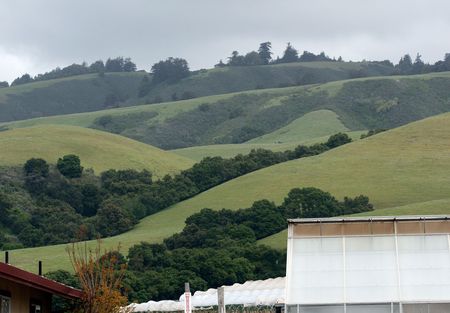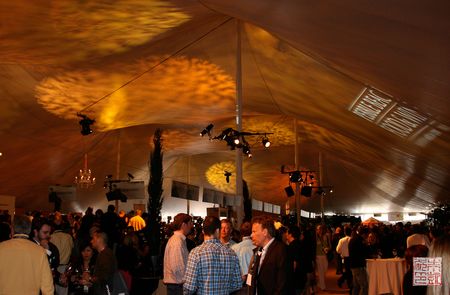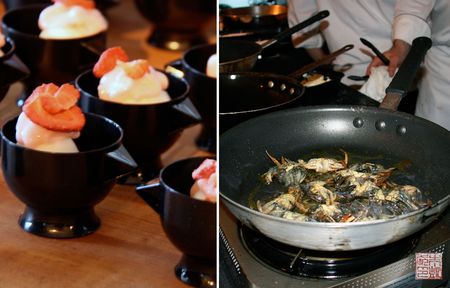Ok, a couple weeks late, but I wanted to do a recap of my visit to the land of strawberries – or, at least, the next best place – Cassin Ranch in Watsonville, a producer of berries for Driscoll’s.
The plastic clamshells with the Driscoll’s label are a familiar sight in grocery stores in the Bay Area, but as they were “supermarket berries” I never gave much thought to where they came from. All that changed when I was offered a spot on a group tour of Cassin Ranch, where I’d get to learn about what goes into growing a perfectly succulent, luscious strawberry.
Cassin Ranch is located in Watsonville, just above Monterey, close enough to the ocean to receive the fog, ocean breezes, and chilly temperatures necessary to grow strawberries. Above is the stunning view of the foothills behind the ranch – so verdant and springlike!
Our hosts were Patrick, one of Driscoll’s berry farmers, and Phil, who works in Driscoll’s R&D developing new varieties of strawberries. Although Driscoll’s grows and sells strawberries, blueberries, blackberries, and raspberries, the largest crop at Cassin Ranch is strawberries, so that was the berry we focused on that day.
Although the containers at the supermarket may just say “Strawberries”, there are in fact thousands of varieties of strawberries grown, and even more being cultivated and studied at Driscoll’s berry farms. Strawberry varieties are developed and chosen for several factors, including taste, shape, and shipping strength.
Phil (who, by the way, has one of the coolest job titles ever – Strawberry Breeding Manager), has the enviable task of taste-testing the results of his research. He says that he has tasted up to 180 berries a day, determining the ones that are most delicious (highly scientific criteria, he admits).
The fruits of his research were undeniable, though, in the gorgeous display of fresh-picked strawberries arranged for us to sample, every berry irresistibly ruddy, plump, and perfectly formed. Although different strawberry varieties are grown at Cassin Ranch, after harvest all the containers of berries are combined together, so which variety ends up at your store is unknown to the customer. However, at the ranch, where several varieties were presented separately for us, it was really easy to see the differences between them.
One of my favorites was the San Juan variety, a classic that’s been around for years, as Phil explained. They had the iconic strawberry shape, full and plump, tapering to a point without being too long or conical, and their taste was pure sweetness, the way I imagine strawberries taste when I’m missing them. (I asked Phil if there were specific terms for describing how different strawberry varieties taste, but he said no, so I don’t feel too bad for my less-than-technical descriptions!)
Another interesting one was the Takara variety, which was specially developed for the Japanese market. In accordance with their passion for aesthetics, the Japanese wanted a small, not too ripe berry that was very uniform in size and would not leak too much juice, for use in their desserts. Hey, there’s a market for those berries here too – what about all of us bakers and dessert lovers in the US!
There were also mystery “test” varieties only labeled by code numbers, ones that might one day be selected to be grown commercially. It can take years for a test variety to make it from research garden to small test plot to being chosen to include in Driscoll’s crops – these people take the quality of their strawberries very seriously.
Another fascinating strawberry-in-progress was a white strawberry – it may look unripe but it tastes fresh and woodsy. Phil said they were developing this strawberry for a potential market in weddings and fancy events. Once you get over the fact that these aren’t anemic berries, I can see how they could add an unusual and elegant touch to a dessert presentation. Not available yet, though!
Patrick, a third generation berry farmer, stepped to elaborate on the strawberry growing process. Strawberries are planted every year to two years, a selection of varieties based on the farm location and its weather and soil conditions. Patrick and other farmers must constantly monitor the changing environment to determine how the plants are doing and make the appropriate adjustments.
Strawberries take about 30 days to mature. Then, they are handpicked in the field and packed directly into the clamshell containers. Patrick offered a tip to picking strawberries – snap, don’t pull. He figured that on average a field workers is able to pick 6 1/2 to 7 cratefuls of strawberries in containers per hour. The fastest Patrick has seen is 20 crates an hour – that’s amazing! To ensure that quality does not suffer, the containers of strawberries are inspected after they have been moved to the chiller to make sure they are the correct weight and also do not have damaged berries.
Chilling strawberries after they are picked helps extend their shelf life. Strawberries you pick up from the store should last at least a week in the fridge without going bad. We took home a pack of strawberries from the ranch that had likely been picked that very morning; I noticed that they definitely stayed fresher for longer in our refrigerator. If only I lived a little closer to the ranch…
We also got to see some of the raspberry plants at the ranch. A lone red raspberry nestling among the leaves. At right, Phil and Patrick, our uber-gracious hosts, pose for a photo.
I left the ranch happy to have learned a little behind the boxes of strawberries I see in the supermarket, and impressed at the passion of Phil and Patrick for their berries. Although I love strawberries, I’ve not devoted my life to understanding and caring for these wonderful little berries like they have, and it’s nice to know that thanks to them and thousands of others like them, we’ll keep getting these beautiful little fruits to enjoy!
Strawberry fields forever. Thanks to Driscoll’s and Cassin Ranch for letting us get a peek at where strawberries come from!
At part of the invitation to visit Cassin Ranch, I was also generously offered the chance to attend the Grand Tasting at the annual Pebble Beach Food and Wine, just down the road in Monterey.
The third iteration of this foodie-and-oenophile event was chock-a-block with wines from around the world and renowned chefs cooking up delectable bites to sample. The tasting tent was overwhelmingly flush with the sounds of music, wine being poured, and sizzling pans.
Angela Pinkerton of Eleven Madison Park’s strawberry and rhubarb with buttermilk sorbet and black pepper; soft shell crabs being prepared for Paul Bartolotta (Bartolotta di Mare)’s dish with octopus salad.
There are already plenty of writeups for Food and Wine, so I won’t repeat them, just say that if you’ve got the spare cash it’s definitely worth trying out once – especially if you’re a wine lover. There were so many wines there it was impossible to try them all in the three-hour event, especially if you’re trying to focus on running around sampling all the food. It also helps if you know a little about wine or what particular wineries or styles you’re interested in. I am a huge dessert wine fan (surprise!), and these were a few of my favorites there:
Far Niente 2005 Dolce – A Napa winery that decided to solely dedicate part of its vineyards to creating a late harvest wine. Dolce is the local answer to Sauternes or Tokaji, a lush mix of Semillon and Sauvignon Blanc, with citrus and peach notes, pleasantly thick but not overly syrupy.
Grgich Hills 2006 Violetta – I’ve been waiting for the Violetta to return since the 2003 release, and this one is a beauty – like pure honey, with almonds and peaches. Ambrosial.
Jorge Ordonez 2005 Malaga Victoria – I haven’t had the chance to try many Spanish dessert wines – there’s a lot of orange and caramel to this one, and very, very sweet.
Tokaji Classic (Loradona Wine Cellars) – This classic dessert wine from Hungary hardly needs more effusive praises, but I was happy to find it being distributed by local Loradona Wine Cellars. Apparently one of the owners likes it so much he wanted to include it in his inventory. Always a pleasure to get a sip of this old favorite!
Disclosure: I visited Cassin Ranch and Pebble Beach Food and Wine as part of a press trip sponsored by Driscoll’s.
P.S. I forgot to mention that the winner of the Taste of the Nation ticket was Allison Daugherty – when I saw her at the event, she seemed to be having a great time! Another food and wine event I need to recap – I know, my life’s been so rough lately!:)









we have those white berries here but they are expensive 🙂
I used to work right down the road from the strawberry ranch. Those field workers (both men and women) sure work hard–sun up to sun down to pick strawberries. Anyway, thanks for sharing!
What an interesting post! Those white strawberries are neat!
What an exciting day! I do love strawberries.
those “white” strawberries are pretty cool
WOW That looks like Tuscany!
Super event Anita!
Bravo!
xcarolg
Thanks for the interesting report. I had no idea that many varieties were packaged together.
If my memory serves me well, Russ Parsons’ “How to Pick a Peach” has some more details about the development of new commercial varieties. It’s amazing how long it takes.
The story of how the strawberry that we know and love came to be is quite interesting. A few years ago I wrote about this long journey on my blog. The short story: two scrawny and unruly species of strawberry came from two opposite coasts of newly colonized continents — the Virginia strawberry (Fragaria virginiana) and the beach strawberry (F. chiloensis) — and accidentally met at the King’s Garden in Paris, were cross-pollinated to make F. ananassa, and the descendants of this hybrid went on to great success as a famous, delicious and versatile fruit.
Wow! Thank you for sharing your visit to the strawberry ranch! I am still not quite sure what it means exactly to “snap” instead of “pull” though. Intriguing!
very nice. i loved every word of this. i am a HUGE lover of driscoll. while they hardly ever make out our way (cape cod), i am more than happy to drive to whole foods to fetch them. those giant organic strawberries just make my spring and summer.
Awesome post! I’ve never heard of white strawberries before! Thanks for sharing.